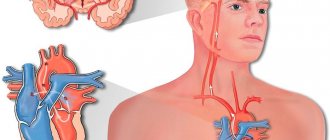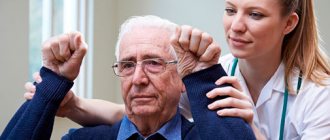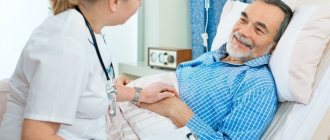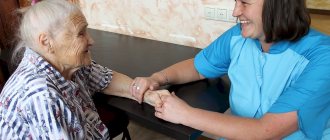Development mechanism
Stroke is a pathological condition that is accompanied by a sudden and severe disruption of blood circulation in any part of the brain. Since neurocytes (cells of the nervous system) are very sensitive to oxygen and energy starvation, when there is a power failure, they die. According to the development mechanism, there are 3 types of stroke:
- Ischemic stroke - blood flow sharply decreases due to a decrease in the diameter of one of the arteries of the brain. Over a short period of time, oxygen starvation develops, followed by cell death. In the absence of help, irreversible changes occur. The pathological process occurs against the background of increased pressure, which provokes spasm of the arterial vessels of the brain or damage to the covering of the atherosclerotic plaque (occurs in atherosclerosis) with subsequent formation of a blood clot. If the reading is above 160/100 mm Hg. Art., the risk of violations increases significantly.
- Hemorrhagic stroke - hemorrhage occurs directly into the brain tissue, which leads to the subsequent death of neurocytes. The pathological condition develops over a short period of time, so it is rarely possible to avoid irreversible changes. Hemorrhagic stroke with low pressure develops against the background of a change in condition and a decrease in the strength of the vascular walls.
- Subarachnoid hemorrhage - blood enters the space between the arachnoid and pia mater of the brain. This leads to a volumetric process, as a result of which the tissues experience mechanical compression, leading to local disruption of blood circulation and nutrition with subsequent death of neurocytes. The pathological process develops over a relatively long period of time, which should usually be enough to provide qualified assistance and prevent irreversible changes.
The division into species depending on the mechanism of development has an important justification. Depending on the pressure at which a stroke occurs, treatment approaches are fundamentally different. Regardless of the origin of the pathological condition, the risk of developing a vascular accident in the brain increases significantly against the background of arterial hypertension (high blood pressure).
Low and high blood pressure
During the first 24 hours after the impact, maintaining high blood pressure is an acceptable norm. The danger is high blood pressure that persists for a week after a stroke. The symptom indicates incorrect treatment. In this case, the patient becomes incapacitated and develops neurological disorders.
Such negative consequences for the patient’s health are due to the continuing increase in cerebral edema, which results in wedging of the brain stem into the occipital part. It is possible that breathing processes may be disrupted until a critical condition develops, as well as heart failure and cardiac arrest.
Complications of hypertensive crisis
If the pressure, despite the therapy, still jumps, then the consequences may be as follows:
- re-strike;
- expansion of the ischemic focus;
- development of encephalopathy;
- hemorrhage in the skull.
Why does a patient have low blood pressure after a stroke and why is this condition considered negative by doctors? A rapid decrease in blood pressure occurs against the background of the following pathological conditions:
- development of a major stroke;
- brain stem damage;
- the formation of cardiogenic shock against the background of a heart attack;
- heart rhythm disturbance;
- dehydration;
- blockage of the pulmonary arteries;
- blood poisoning;
- aneurysm.
Low blood pressure values during the rehabilitation period indicate progression of the pathology. The prognosis in this case is extremely unfavorable, this applies to both recovery and human life. A decrease in blood pressure can occur against the background of regular use of hypertensive drugs that were prescribed to the patient even before the stroke developed.
But if the reason for this is not drug treatment, then this is a signal that the body is unable to independently regulate blood pressure as a result of impaired cerebral blood circulation. Medical statistics show that severe hypotension during the first few days after a stroke causes the death of the patient.
No ads 3
When should you reduce?
Blood pressure is the force with which blood presses on the walls of the arteries, stretching them. This is a very important hemodynamic indicator, on which the speed and volume of blood flow in peripheral tissues depends. What pressure can be caused by a stroke is determined by several factors:
- heart rate and amplitude;
- total volume of the vascular bed;
- volume of circulating blood.
An increase in blood pressure can occur due to increased heart rate, spasm of arterial vessels (decreased vascular volume) or an increase in the volume of circulating blood (fluid retention in the body). The normal pressure level is different for each person, but it should not exceed 140/90 mmHg. Art. Arterial hypertension increases the risk of developing a cardiovascular accident, which includes cerebral stroke and myocardial infarction. If the reading is more than 180/100 mmHg. Art. the likelihood of ischemic or hemorrhagic stroke increases several times.
Heart attack and stroke: signs, emergency care, prevention
Myocardial infarction is a disease in which, due to blockage of the coronary artery, the full blood supply to an area of the heart muscle (myocardium) suddenly and abruptly stops, which leads to a severe lack of oxygen (ischemia), nutrients and death of myocardial cells. This area can no longer take part in heart contractions, so the heart cannot provide blood flow to the body. All organs and tissues begin to experience oxygen starvation, which leads to disruption of their function. The main cause of heart attack is elevated levels of cholesterol and certain lipids in the blood.
Typical manifestations of myocardial infarction are a feeling of severe pressure or pain behind the sternum, or slightly to the left or right of it. The pain is most often squeezing, pressing, tearing (feeling of a stake in the chest), sometimes burning. Irradiation of pain to the left shoulder girdle, shoulder, arm, less often to the neck and lower jaw, sometimes to the right half of the shoulder girdle is typical. Occasionally, the pain is localized in the epigastric region. Unlike angina, pain during myocardial infarction lasts more than half an hour, usually several hours. Nitroglycerin taken brings only minor and short-term relief. Severe weakness and cold sweat are often noted. Often in the acute stage of myocardial infarction, patients experience nausea, vomiting, hiccups, and bloating, which are of a reflex nature. In some cases, myocardial infarction is practically asymptomatic.
During the period of pain, the patient's face has a suffering appearance, the skin is usually pale, sometimes with a cyanotic tint. Breathing is rapid. Blood pressure may rise when pain occurs, but soon drops to an unusually low level for the patient. The pulse is frequent, heart sounds are weakened. In most patients, various cardiac arrhythmias can be detected.
If you or someone else suddenly has the above characteristic signs of a heart attack, even with weak or moderate intensity, which last more than 5 minutes, do not hesitate, immediately call an ambulance team. Do not wait more than 10 minutes - in such a situation it is life-threatening.
The recovery period after a myocardial infarction lasts 4-6 weeks. It occurs differently in different patients. Most often, during this period, patients remain able to work, but they sometimes experience angina attacks. In rare cases, the course of the post-infarction period is interrupted by the onset of a second infarction.
The results of large-scale international studies, in particular the INTERHEART study, showed that the following factors have a decisive influence on the risk of developing myocardial infarction: dyslipidemia, smoking, hypertension, abdominal obesity, psychosocial factors (stress, social isolation, depression), diabetes mellitus, reduce the risk : eating enough vegetables and fruits, regular physical activity.
Emergency self-help and mutual assistance measures in case of a heart attack (myocardial infarction).
In our country, up to 80% of deaths occur outside of medical organizations - at home, at work, in the country, in public and other places. Most of them occur suddenly or by the mechanism of sudden death. However, with knowledge of simple first aid techniques on the part of people surrounding a person who finds himself in such a critical condition, as well as everyone’s knowledge of first self-help measures, can in most cases save the patient’s life.
Characteristic signs (symptoms) of a heart attack (myocardial infarction)
• sudden (paroxysmal) pressing, squeezing, burning, aching pain in the chest (behind the sternum) lasting more than 5 minutes;
• similar pains are often observed in the left shoulder (forearm), left shoulder blade, left half of the neck and lower jaw, both shoulders, both arms, the lower part of the sternum along with the upper abdomen;
• lack of air, shortness of breath, severe weakness, cold sweat, nausea often occur together and sometimes follow or precede discomfort/pain in the chest
• often these manifestations of the disease develop against the background of physical or psycho-emotional stress, but more often with some interval after them.
Algorithm of urgent actions:
• Call an emergency medical team.
• Sit (preferably in a chair with armrests) or lie in bed with the head of the bed raised, take 0.25 g of acetylsalicylic acid (aspirin) (chew the tablet, swallow) and 0.5 mg of nitroglycerin (put the tablet/capsule under the tongue, first bite the capsule , do not swallow); free your neck and provide fresh air (open the vents or windows).
• If after 5-7 min. After taking acetylsalicylic acid (aspirin) and nitroglycerin, pain persists, you need to take nitroglycerin a second time.
• If pain persists 10 minutes after taking the second dose of nitroglycerin, it is necessary to take nitroglycerin a third time.
• If after the first or subsequent doses of nitroglycerin there is severe weakness, sweating, shortness of breath, you need to lie down, raise your legs (on a bolster, etc.), drink 1 glass of water and then, as with a severe headache, do not take nitroglycerin.
• If the patient has previously taken cholesterol-lowering medications, give the patient his usual daily dose and take the drug with you to the hospital.
Attention! A patient with a heart attack is strictly forbidden to get up, walk, smoke or eat until the doctor’s special permission;
You should not take aspirin (acetylsalicylic acid) if you are intolerant to it (allergic reactions), as well as with obvious or worsening peptic ulcers of the stomach and duodenum;
Nitroglycerin should not be taken if there is severe weakness, sweating, or if there is severe headache, dizziness, or acute impairment of vision, speech, or coordination of movements.
Prevention of myocardial infarction.
As for the prevention of atherosclerosis, everyone who has become familiar with the factors contributing to its occurrence knows what to do. The one who sharply reduces the consumption of animal fats and develops a rational attitude to nutrition will do the right thing. You should eat low-fat cottage cheese and low-fat kefir. More fiber-rich vegetables should be included in the menu - raw and sauerkraut, beets, carrots (at least 500 g per day). Fiber helps remove excess cholesterol from the body. When the first cases of increased pressure are detected, for which you need to regularly, at least once every one to two months, measure blood pressure and, by contacting a doctor, take the necessary measures, it is quite possible to stop the development of hypertension (blood pressure should not be higher than 140/90 mm Hg. Art.). If elevated cholesterol levels are determined, then by resorting to dietary and drug treatment, the progression of atherosclerosis can be delayed (the maximum permissible level of cholesterol in the blood is 5 mmol/l). The most important preventive measure is to stop smoking. Harmful substances in cigarette smoke contribute to the development and progression of atherosclerosis, cause fluctuations in blood pressure, thicken the blood and provoke thrombosis. The danger is posed by so-called passive smoking, so it is important not only to quit smoking, but also not to be in areas where smoking is allowed and in the company of smokers. Smoking significantly reduces the effect of physical training, so the desire to achieve the maximum effect from exercise and lead an active lifestyle is another reason to stop smoking.
In order to timely identify initial disturbances in the activity of the cardiovascular system and, if necessary, prescribe optimal drug treatment that can prevent the development of myocardial infarction, experts strongly advise regular medical examinations or preventive medical examinations at the clinic at the place of residence.
Finally, it is important to remember that only a doctor prescribes treatment for a heart attack, and the patient and his relatives strictly follow the instructions. Self-medication of a heart attack, no matter how easy it may be, is unacceptable!
Stroke: causes, symptoms, prevention.
In the modern world, people suffer from such a disease as “stroke” more often than from “myocardial infarction”. Residents of large cities are most susceptible to this disease, where life is full of stress and anxiety, and there is also an unfavorable environmental situation. Stroke accounts for approximately 6 million deaths per year worldwide and is second only to coronary heart disease as a cause of death.
A stroke is a terrible blow, which often divides not only the life of the patient, but also the life of his family into two parts: “Before” and “After”. Everything can change overnight: an active, active person can become a helpless disabled person in need of constant outside help, caring for which places a heavy burden on his loved ones, creating considerable socio-economic difficulties for society. What kind of life are people forced to lead after suffering a severe stroke? This is a real genuine tragedy and tears invisible to the world, since for many of them even leaving the apartment is an insoluble problem, and it is not so rare that the disease is bedridden, making the patient completely dependent on others.
A stroke is an acute disorder of cerebral circulation, leading to damage to the brain substance and disruption of its functions. There are two types of this disease: ischemic stroke and hemorrhagic stroke. Ischemic stroke occurs when the lumen of a vessel is blocked by a thrombus or embolus. The cause of a hemorrhagic stroke is a rupture of the vessel wall and blood entering the brain.
Many risk factors for stroke are common to other cardiovascular diseases. They are divided into two large groups: internal - high blood pressure, age, family history (stroke, myocardial infarction, hypertension in close relatives), high blood cholesterol, obesity; external – emotional stress, sedentary lifestyle, bad habits, environmental features. In addition, stroke has risk factors unique to it: initial manifestations of insufficient blood supply to the brain, dyscirculatory encephalopathy, transient cerebrovascular accidents, and previous strokes.
The onset of a stroke can vary. Hemorrhagic stroke occurs suddenly. Subsequently, patients can even indicate at what hour and even minute they began to experience symptoms of the disease: severe headache, vomiting, dizziness, weakness, malaise. There may be a deterioration in a person’s orientation in the surrounding space, difficulty speaking, loss of consciousness, and the development of paralysis. With ischemic stroke, the onset may be slow. Often patients note increasing sensations of weakness in one half of the body, a gradual deterioration in speech, swallowing, facial distortion, and unsteady gait.
When the first such signs appear, the most correct thing is to immediately call an ambulance and hospitalize the patient in the neurological department. If a person’s stroke has developed acutely, with loss of consciousness and signs of paralysis, before the ambulance arrives, the patient must be turned on his side and a pillow placed under his head (if this happened at home); rolled up clothes or a bag (if this happened outside the home). To make breathing easier, unfasten your collar and, holding your head with your hands, constantly wipe away the foam with a handkerchief so that it does not get into your respiratory tract. To prevent the patient from biting his tongue, a comb or stick wrapped in a scarf can be inserted between the teeth. You cannot hold your arms and legs with force, trying to unclench your cramped fingers, much less lean on the patient with your whole body. This may make the seizure worse. The patient's arms and legs should only be held lightly so that he does not injure himself and others. And no ammonia! It may cause respiratory arrest. You cannot move a patient during an attack. If the patient’s pulse cannot be felt, the heart has stopped, and breathing has stopped, an indirect cardiac massage and mouth-to-mouth artificial respiration must be performed. Everything else is the task of the ambulance team.
Stroke prevention is based on the basic principles of a healthy lifestyle.
· Know and control your blood pressure - it should not be more than 140/90 mmHg.
· Do not start smoking or stop smoking as soon as possible.
· Add as little salt as possible to your food and avoid canned and processed foods that contain it in excess.
· Control your blood cholesterol levels – the maximum allowable level is 5 mmol/l.
· Follow the basic principles of a healthy diet - eat more vegetables and fruits (at least 500 g per day), avoid added sugar and saturated animal fat.
· Don't drink alcohol. The risk of stroke is highest in the first hours after drinking alcohol.
· Exercise regularly. Even moderate physical activity (walking outdoors for 30 minutes a day) reduces the risk of developing cardiovascular diseases, including stroke.
Preventative medical examinations and consultations that you can undergo:
— in a clinic at your place of residence, where you can undergo medical examination or in-depth preventive examination;
— at the Health Center (in Krasnodar at Tramvaynaya str., 5), where your blood pressure will be measured, your blood glucose and cholesterol levels will be determined, and your body mass index will be calculated. Knowing your risk for developing heart disease can help you develop a specific action plan to improve your heart health.
Causes
Brain stroke is a polyetiological pathological condition. This means that its development is provoked by several reasons, which include:
- Atherosclerosis is the main cause of cardiovascular disease. The pathological condition is characterized by the deposition of cholesterol in the walls of arterial vessels with the formation of atherosclerotic plaques. They reduce the lumen of the artery, due to which blood flow in the tissues worsens. Against the background of increased pressure, damage to the covering of the atherosclerotic plaque often occurs, which provokes the intravascular formation of blood clots with subsequent blockage of blood vessels.
- Hypertension - a prolonged increase in the level of systemic blood pressure causes a number of changes in the vessels of the brain, leading to a deterioration in blood flow in the tissues. Also, the pathological condition provokes the rupture of atherosclerotic plaques with the formation of blood clots. High blood pressure during stroke in women is often recorded during the postmenopausal period, which is associated with hormonal changes in the body.
- An increased tendency of blood to clot is a factor leading to spontaneous intravascular formation of blood clots (thrombosis). Clots with blood flow move in the vascular bed and clog the arteries, followed by a sharp cessation of blood flow in them.
- Thrombophlebitis is an inflammatory process in the venous vessels with a predominant localization in the lower extremities, which is accompanied by the spontaneous formation of blood clots.
- Malformation of arterial vessels is a congenital pathology, which is characterized by the formation of a “tangle” of arteries of various sizes in one place. At the same time, most of the vessels have low wall strength, which leads to their damage and the development of hemorrhage. The likelihood of this outcome is higher with high blood pressure.
- Congenital disorders in the walls of arterial vessels, which are accompanied by a decrease in the strength of their walls, are one of the factors in the development of hemorrhagic stroke in adults, less often in children.
Knowledge of the reasons for the increase in systemic blood pressure and the development of cerebral stroke is necessary for choosing measures aimed at preventing the pathological condition.
Female sex hormones estrogens protect arterial vessels from the appearance of atherosclerotic plaques. All problems with the heart, blood vessels, and an increased likelihood of developing a cerebral stroke in women occur during the decline of reproductive function with a decrease in the level of estrogen in the blood.
Causes of blood pressure surges
A sharp fluctuation in blood pressure after a stroke occurs when the organs and systems of the body are unable to perform their functions. Most often it is the brain that is affected. Against the background of unstable blood pressure, both cardiac and peripheral circulation worsens, and the destruction of the walls of blood vessels also occurs. The patient develops an acute form of atherosclerosis. The development of recurrent strokes cannot be ruled out.
The main danger lies not in the increase or decrease in pressure, but in its constant fluctuation
The leading causes of sudden changes in blood pressure that occur after a stroke are:
- disturbances in the functioning of the central nervous system;
- low mobility of the vasomotor center;
- high blood sugar levels;
- hormonal imbalance;
- changes in the electrolyte composition of the blood.
Important! With a hemorrhagic stroke, the risk of developing a second stroke is high. This usually happens on the fifth or sixth day after the first blow.
Blood pressure after stroke
Pressure after a cerebral stroke has a great influence on subsequent tissue regeneration, the effectiveness of treatment, and the duration of the early and late recovery period. In the first minutes of providing qualified assistance, a medical professional measures hemodynamic parameters, which makes it possible to make a forecast regarding the further normalization of brain functions, as well as select adequate treatment. Therapeutic measures depend on the results of measuring blood pressure and pulse:
- The indicator is above 180/100 mmHg. Art. – measures aimed at lowering the level of systemic blood pressure are required, since there remains a very high risk of ongoing disruption of blood flow involving a large volume of tissue.
- The indicator varies between 140/90-160/100 mm Hg. Art. – correction of blood pressure cannot be carried out, since if the indicator decreases excessively, blood perfusion in the brain tissues sharply decreases, which leads to the progression of ischemic stroke even after a hemorrhage in the tissue.
- The indicator is less than 110/70 mmHg. Art. – depending on the general condition of a person who has suffered a cerebral stroke, measures aimed at increasing the level of systemic blood pressure may be required. This will make it possible to improve blood perfusion in brain tissue and their nutrition.
When providing assistance, pay attention to the heart rate. Typically, there is an increase in heart rate during a stroke, while the amplitude of heart contractions decreases, as a result of which blood flow in peripheral tissues worsens.
Signs
It is easy to suspect a cerebral stroke based on the following clinical manifestations of a cardiovascular accident:
- Pointed, intense headache in the area of development of the pathological process is a symptom that usually occurs with the development of a hemorrhagic stroke.
- Impaired consciousness of varying severity - depending on the degree of brain damage, a stunned state or a complete lack of consciousness is possible (a person may suddenly fall), even to coma.
- Severe nausea, which is accompanied by periodic vomiting that does not bring relief.
- Change in skin color - in most cases, the facial area acquires a bluish tint (cyanosis); pallor is less common.
- Development of tonic-clonic convulsions of striated skeletal muscles of varying severity. A person may fall unexpectedly (the fall is accompanied by involuntary muscle contraction).
- Focal neurological symptoms - depending on the location of a sharp circulatory disorder in the brain tissue, there is a deviation (deviation to the side) of the tongue, a decrease or complete loss of all types of skin sensitivity in certain areas of the body, weakness in the muscles or a complete inability to move them, speech impairment, facial asymmetry, different pupil diameters. Focal symptoms usually appear on one side of the body. With a volumetric stroke of the brain, impaired muscle movements (paresis or paralysis) can be detected in both arms and legs.
The appearance of several signs of the development of a cerebral stroke requires immediate assistance with the initiation of adequate therapeutic measures.
Symptoms of changes in pressure levels
To provide assistance, it is important to understand what blood pressure accompanies the development of the pathological process. If it is not possible to directly measure hemodynamic parameters (there is no tonometer), then you need to pay attention to the clinical signs of arterial hypertension or hypotension:
- High blood pressure is accompanied by a headache with a predominant localization in the back of the head, less often the crown. Visual acuity often decreases, “spots” appear before the eyes, general weakness, and unpleasant sensations in the heart area are troubling. Over time, signs of high blood pressure increase, and then stroke symptoms appear.
- Stroke with low blood pressure - the pathological process is often accompanied by dizziness, the head may hurt in the forehead, temples, and the pain is pulsating in nature. Against the background of dizziness, tinnitus appears, which increases as blood flow in the brain tissue deteriorates. In such cases, the pressure needs to be increased.
- Stroke with normal blood pressure often occurs in young people. The cause is almost always a decrease in the strength of the walls of arterial vessels. Against the background of normal health, the clinical picture of a hemorrhagic stroke suddenly appears, and the person loses consciousness.
Low blood pressure after a stroke is considered an unfavorable prognostic criterion, in which deterioration of blood circulation in the brain despite therapeutic measures may have a progressive course. It is usually recorded when there is a repeated circulatory disorder.
Stroke in hypotensive patients
The development of a stroke is also possible with low blood pressure (in people suffering from hypotension). The formation of pathology is due to the body’s inability to independently eliminate the impending blow. A stroke in hypotensive patients can be triggered by features of a person’s lifestyle, stressful situations, disturbances in the functioning of internal organs and systems as a whole, and the use of antihypertensive medications.
The cause of stroke development against the background of hypotension can be:
- a sharp increase in blood pressure - occurs as a result of severe stress, overwork, as a side effect of the drug;
- rupture of an aneurysm - can be triggered by lifting weights, staying in a prolonged inclined position in hot rooms or under the open sun - a violation of the integrity of the vessel occurs as a result of overstrain;
- bleeding disorder - in this case, the likelihood of blood clots and blockage of blood vessels in the brain increases.
In the chronic form of hypotension, the likelihood of developing an ischemic stroke increases significantly with age. In the presence of cardiovascular pathologies, the risk of hemodynamic stroke increases. This is a subtype of the ischemic form, caused by circulatory decompensation. Its cause may be:
- atrioventricular block;
- myocardial infarction;
- weak sinus syndrome;
- atrial fibrillation.
Parkinson's disease is often accompanied by hypotensive crises, which, in turn, can cause the development of hemodynamic stroke. In hypotensive patients, signs indicating the formation of a hemorrhagic form of stroke are almost completely absent.
The condition is characterized by a slow onset and a long period of persistence of symptoms of brain damage with low blood pressure. The patient does not experience loss of consciousness or headaches. But almost all the precursors are typical for ischemic stroke. Most often, symptoms occur at night or in the morning.
[node:field_similarlink]
Diagnosis and treatment
To determine the level of systemic blood pressure, a digital or dial tonometer is used. If there is no device, then pay attention to clinical symptoms and focus on assessing the frequency and strength of heart contractions. Hemodynamic correction is carried out depending on the severity of changes:
- For high blood pressure in men and women, parenteral forms of antihypertensive drugs are prescribed, which can reduce the level within 10-15 minutes. For this purpose, magnesium, papaverine with dibazole, and diuretics (furosemide) are administered. If it is not possible to give an injection, then you need to take tablets or drops orally (Captopress, Farmadipin).
- With low blood pressure, the patient is prescribed injection drugs that increase arterial tone and heart rate (cordiamin, dexamethasone).
If, due to low pressure, it is not possible to administer drugs, then the patient is placed on his back with his legs elevated (a bolster can be used). This will increase blood flow to the brain tissue.
The pressure indicator during cerebral stroke has an important influence on the choice of therapeutic measures. The indicator must be measured using a tonometer. If there is no device, then hemodynamics are roughly assessed based on clinical signs, including complaints that preceded the development of a stroke.







